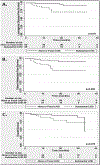Is Substantial Lymphovascular Space Invasion Prognostic for Clinical Outcomes in Type II Endometrial Cancer?
- PMID: 35264314
- PMCID: PMC9296073
- DOI: 10.1016/j.clon.2022.02.018
Is Substantial Lymphovascular Space Invasion Prognostic for Clinical Outcomes in Type II Endometrial Cancer?
Abstract
Aims: Substantial lymphovascular space invasion (LVSI) compared with none or focal LVSI is predictive of lymph node involvement and worse clinical outcomes in endometrioid-type endometrial carcinoma. We aimed to quantify the incidence of substantial LVSI in type II (clear cell and serous) endometrial cancer and correlate the extent of LVSI with clinical outcomes.
Materials and methods: A retrospective review was conducted on type II endometrial cancer patients who underwent surgical management from July 2017 to December 2019 using the three-tier LVSI scoring system. Binary logistic regression and Cox regression were used to analyse predictors of lymph node involvement or survival outcomes, respectively. The Kaplan-Meier method and Log-rank test were used to analyse differences in locoregional disease-free survival (LR-DFS), distant metastasis disease-free survival (DM-DFS) and overall survival between patients with substantial versus none/focal LVSI.
Results: In 79 patients with type II endometrial carcinoma, no LVSI, focal LVSI and substantial LVSI was present in 48.1%, 15.2% and 36.7% of patients, respectively. Lymph nodes were involved in 0.0% with no LVSI, 20.0% with focal LVSI and 60.0% with substantial LVSI (P < 0.001). The median follow-up was 22.2 months. In patients with none/focal versus substantial LVSI, the 2-year LR-DFS and DM-DFS rates were 91.5% versus 71.4% (P = 0.01) and 90.2% versus 63.8% (P = 0.005), respectively. On univariate analysis, myometrial invasion ≥50%, tumour size ≥3.6 cm, substantial versus none/focal LVSI, lymph node involvement and omission of adjuvant radiotherapy were significant predictors for worse LR-DFS and DM-DFS (P < 0.05).
Discussion: Substantial LVSI has a high incidence in type II pathology at our institution and predicts for lymph node involvement and worse clinical outcomes.
Keywords: Clear cell endometrial carcinoma; serous endometrial carcinoma; substantial lymphovascular space invasion; type II endometrial carcinoma; uterine cancer.
Copyright © 2022 The Royal College of Radiologists. Published by Elsevier Ltd. All rights reserved.
Conflict of interest statement
Conflicts of interest
S. Beriwal reports a relationship with Varian Medical Systems Inc. that includes: employment. S. Beriwal reports a relationship with Via Oncology that includes: consulting or advisory. S. Beriwal reports a relationship with Xoft Inc. that includes: consulting or advisory. J.A. Vargo reports a relationship with Elsevier Inc., Clinical Pathways that includes: consulting or advisory.
Figures

Similar articles
-
Is Substantial Lymphovascular Space Invasion Prognostic in Patients With Pathologically Lymph Node-Negative Endometrial Cancer?Int J Radiat Oncol Biol Phys. 2023 Sep 1;117(1):148-153. doi: 10.1016/j.ijrobp.2023.02.053. Epub 2023 Mar 8. Int J Radiat Oncol Biol Phys. 2023. PMID: 36893818 Free PMC article.
-
Is the risk of substantial LVSI in stage I endometrial cancer similar to PORTEC in the North American population? - A single-institution study.Gynecol Oncol. 2020 Oct;159(1):23-29. doi: 10.1016/j.ygyno.2020.07.024. Epub 2020 Jul 25. Gynecol Oncol. 2020. PMID: 32718729
-
The prognostic impact of substantial lymphovascular space invasion in women with node negative FIGO stage I uterine carcinoma.Gynecol Oncol. 2024 Sep;188:44-51. doi: 10.1016/j.ygyno.2024.06.009. Epub 2024 Jun 26. Gynecol Oncol. 2024. PMID: 38936280
-
Practical guidance for assessing and reporting lymphovascular space invasion (LVSI) in endometrial carcinoma.Histopathology. 2025 Jan;86(2):173-182. doi: 10.1111/his.15272. Epub 2024 Jun 27. Histopathology. 2025. PMID: 38937066 Free PMC article. Review.
-
[Metastatic mechanisms of uterine malignancies and therapeutic consequences].Pathologe. 2016 Nov;37(6):549-556. doi: 10.1007/s00292-016-0243-z. Pathologe. 2016. PMID: 27757531 Review. German.
Cited by
-
An analysis of adjuvant chemoradiotherapy versus chemotherapy on the survival rates for patients with stage IB-III uterine serous carcinoma.Sci Rep. 2024 Mar 11;14(1):5884. doi: 10.1038/s41598-024-53172-3. Sci Rep. 2024. PMID: 38467644 Free PMC article.
-
Uterine Carcinosarcoma: Adaptation to New FIGO 2023 Staging System Through Clinical Profile and Oncologic Outcomes.J Clin Med. 2025 Mar 27;14(7):2299. doi: 10.3390/jcm14072299. J Clin Med. 2025. PMID: 40217749 Free PMC article.
-
The impact of lymphovascular space invasion on survival in early stage low-grade endometrioid endometrial cancer.Eur J Med Res. 2023 Mar 13;28(1):118. doi: 10.1186/s40001-023-01084-9. Eur J Med Res. 2023. PMID: 36915143 Free PMC article.
-
Assessing Metabolic Risk Factors for LVSI in Endometrial Cancer: A Cross-Sectional Study.Ther Clin Risk Manag. 2022 Aug 9;18:789-798. doi: 10.2147/TCRM.S372371. eCollection 2022. Ther Clin Risk Manag. 2022. PMID: 35971461 Free PMC article.
-
Establishment and validation of a prognostic nomogram for overall survival in type II endometrial carcinoma patients.Sci Rep. 2025 Mar 6;15(1):7801. doi: 10.1038/s41598-025-91261-z. Sci Rep. 2025. PMID: 40050355 Free PMC article.
References
-
- Bosse T, Peters EEM, Creutzberg CL, Jürgenliemk-Schulz IM, Jobsen JJ, Mens JWM, et al. Substantial lymph-vascular space invasion (LVSI) is a significant risk factor for recurrence in endometrial cancer – a pooled analysis of PORTEC 1 and 2 trials. Eur J Cancer 2015;51:1742–1750. 10.1016/j.ejca.2015.05.015. - DOI - PubMed
MeSH terms
Grants and funding
LinkOut - more resources
Full Text Sources

